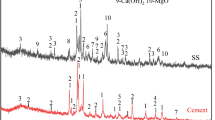Abstract
Steel slag is a calcium-rich but hydration-inactive material. Accelerated carbonation is an effective method to activate its reactivity. In this study, a kind of widely available steel slag, basic oxygen furnace slag (BOFS), was used as the sole material for fabricating dry-mixed compacts; the interactions of casting pressure, water to solid (w/s) ratio and carbonation duration were investigated in terms of their effects on CO2 uptake and compressive strength, with the emphasis of finding the parametric interdependence and the optimized parameters. The results suggested that the casting pressure and water addition determined the framework i.e., initial air voids for BOFS activation. The initial air voids inherent in different sample preparation scenarios described the CO2 uptake and strength behavior. It was found that the optimal casting pressure and w/s for BOFS carbonation to achieve the highest compressive strength (45.57 ± 2.10 MPa) and sequestrate considerable amount of CO2 (9.56 wt%) were 15 MPa and 0.13, respectively. Additionally, adopting optimized parameters enabled the exemption of preconditioning and could simplify the curing process at plant setting. It was also highlighted in this study that the maximized density did not correspond to the highest strength since over compactness of the matrix could restrain the CO2 diffusion for carbonation. Also, portlandite, brucite, larnite, tricalcium aluminate, brownmillerite and some amorphous phases were the critical reactive phase towards carbonation while metal oxides and their solid solution were inert. This study provided insight into the development of CO2-activated BOFS-based construction products towards either environment- or property highlighted purposes.










Similar content being viewed by others
References
Wang P, Ryberg M, Yang Y et al (2021) Efficiency stagnation in global steel production urges joint supply- and demand-side mitigation efforts. Nat Commun 12:1–11. https://doi.org/10.1038/s41467-021-22245-6
National Bureau of Statistics of China (2020) China Statistical Yearbook 2020. http://www.stats.gov.cn/tjsj/ndsj/2020/indexch.htm. Accessed from 30 June 2021
Guo J, Bao Y, Wang M (2018) Steel slag in China: treatment, recycling, and management. Waste Manag 78:318–330. https://doi.org/10.1016/j.wasman.2018.04.045
National Development and Reform Commission (2021) Guiding Opinions on the Comprehensive Utilization of Bulk Solid Wastes in the "14th Five-Year Plan". https://www.ndrc.gov.cn/xxgk/zcfb/tz/202103/t20210324_1270286.html. Accessed from 30 June 2021
Wang D, Chang J, Ansari WS (2019) The effects of carbonation and hydration on the mineralogy and microstructure of basic oxygen furnace slag products. J CO2 Util 34:87–98. https://doi.org/10.1016/j.jcou.2019.06.001
Wang X, Ni W, Li JJ et al (2019) Carbonation of steel slag and gypsum for building materials and associated reaction mechanisms. Cem Concr Res 125:105893. https://doi.org/10.1016/j.cemconres.2019.105893
Wang Q, Yan PY, Yang JW, Zhang B (2013) Influence of steel slag on mechanical properties and durability of concrete. Constr Build Mater 47:1414–1420. https://doi.org/10.1016/j.conbuildmat.2013.06.044
Mahoutian M, Shao YX (2016) Production of cement-free construction blocks from industry wastes. J Clean Prod 137:1339–1346. https://doi.org/10.1016/j.jclepro.2016.08.012
Ghouleh Z, Guthrie RIL, Shao YX (2017) Production of carbonate aggregates using steel slag and carbon dioxide for carbon-negative concrete. J CO2 Util 18:125–138. https://doi.org/10.1016/j.jcou.2017.01.009
Mo L, Zhang F, Deng M (2016) Mechanical performance and microstructure of the calcium carbonate binders produced by carbonating steel slag paste under CO2 curing. Cem Concr Res 88:217–226. https://doi.org/10.1016/j.cemconres.2016.05.013
Shi CJ, He F, Wu Y (2012) Effect of pre-conditioning on CO2 curing of lightweight concrete blocks mixtures. Constr Build Mater 26(1):257–267. https://doi.org/10.1016/j.conbuildmat.2011.06.020
Zhan BJ, Xuan DX, Zeng WL, Poon CS (2019) Carbonation treatment of recycled concrete aggregate: effect on transport properties and steel corrosion of recycled aggregate concrete. Cem Concr Compos 104:103360. https://doi.org/10.1016/j.cemconcomp.2019.103360
Zhang D, Shao YX (2016) Early age carbonation curing for precast reinforced concretes. Constr Build Mater 113:134–143. https://doi.org/10.1016/j.conbuildmat.2016.03.048
Rostami V, Shao YX, Boyd AJ (2012) Carbonation curing versus steam curing for precast concrete production. J Mater Civ Eng 24(9):1221–1229. https://doi.org/10.1061/(ASCE)MT.1943-5533.0000462
Zhan BJ, Xuan DX, Poon CS, Shi CJ (2019) Mechanism for rapid hardening of cement pastes under coupled CO2-water curing regime. Cem Concr Compos 97:78–88. https://doi.org/10.1016/j.cemconcomp.2018.12.021
Han SH, Jun Y, Shin TY, Kim JH (2020) CO2 curing efficiency for cement paste and mortars produced by a low water-to-cement ratio. Materials 13(17):3883. https://doi.org/10.3390/ma13173883
Humbert PS, Castro-Gomes JP, Savastano H (2019) Clinker-free CO2 cured steel slag based binder: optimal conditions and potential applications. Constr Build Mater 210:413–421. https://doi.org/10.1016/j.conbuildmat.2019.03.169
Montgomery DC (2017) Design and analysis of experiments. John Wiley & Sons, Arizona State University, Amsterdam
Scrivener K, Snellings R, Lothenbach B (2018) A practical guide to microstructural analysis of cementitious materials. CRC Press, Florida
Rakić T, Kasagić-Vujanović I et al (2014) Comparison of full factorial design, central composite design, and box-behnken design in chromatographic method development for the determination of fluconazole and its impurities. Anal Lett 47(8):1334–1347. https://doi.org/10.1080/00032719.2013.867503
Bahar R, Benazzoug M, Kenai S (2004) Performance of compacted cement-stabilised soil. Cement Concr Compos 26(7):811–820. https://doi.org/10.1016/j.cemconcomp.2004.01.003
Beckett C, Ciancio D (2014) Effect of compaction water content on the strength of cement-stabilized rammed earth materials. Can Geotech J 51(5):583–590
Funding
This study was funded by the National Natural Science Foundation of China (51950410584 & 52078202).
Author information
Authors and Affiliations
Contributions
Conceptualization: Yi Jiang, Tung-Chai Ling; Methodology: Yi Jiang; Formal analysis and investigation: Yi Jiang; Writing-original draft preparation: Yi Jiang; Writing-review and editing: Tung-Chai Ling; Funding acquisition: Tung-Chai Ling; Resources: Yi Jiang; Supervision: Tung-Chai Ling.
Corresponding author
Ethics declarations
Conflicts of interest
The authors declare that they have no conflict of interest.
Data availability
Part of the experimental data used in the current study are included in the article and its supplementary information files.
Additional information
Publisher's Note
Springer Nature remains neutral with regard to jurisdictional claims in published maps and institutional affiliations.
Supplementary Information
Below is the link to the electronic supplementary material.
Rights and permissions
About this article
Cite this article
Jiang, Y., Ling, TC. Interdependent factors contributing towards carbonation of steel slag compact: consideration of casting pressure, water dosage and carbonation duration. Mater Struct 54, 176 (2021). https://doi.org/10.1617/s11527-021-01768-w
Received:
Accepted:
Published:
DOI: https://doi.org/10.1617/s11527-021-01768-w




